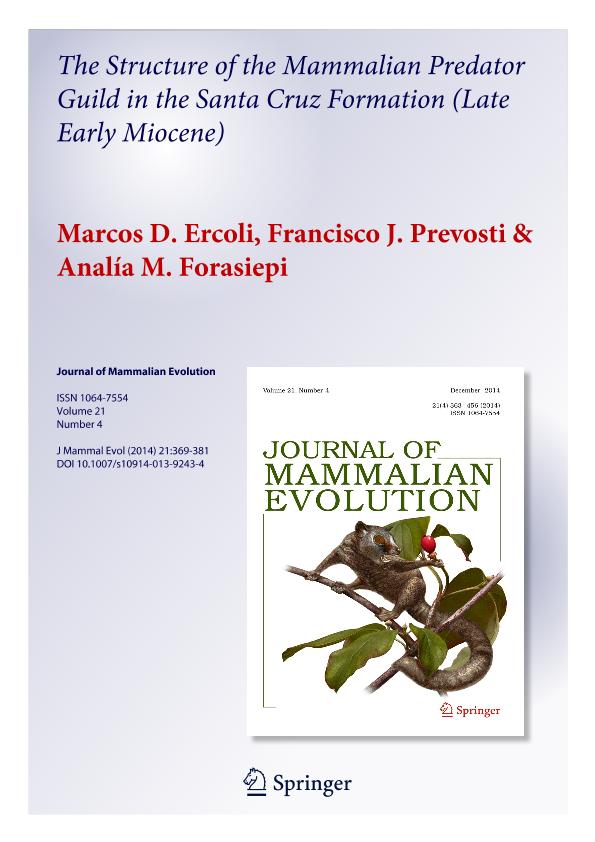Mostrar el registro sencillo del ítem
dc.contributor.author
Ercoli, Marcos Darío

dc.contributor.author
Prevosti, Francisco Juan

dc.contributor.author
Forasiepi, Analia Marta

dc.date.available
2017-06-29T15:57:58Z
dc.date.issued
2014-12
dc.identifier.citation
Ercoli, Marcos Darío; Prevosti, Francisco Juan; Forasiepi, Analia Marta; The Structure of the Mammalian Predator Guild in the Santa Cruz Formation (Late Early Miocene); Springer; Journal of Mammalian Evolution; 21; 4; 12-2014; 369-381
dc.identifier.issn
1064-7554
dc.identifier.uri
http://hdl.handle.net/11336/19136
dc.description.abstract
The Santa Cruz Formation (late early Miocene, Santacrucian age) registers 11 species of mammalian predators (Metatheria, Sparassodonta). Together with large carnivorous flightless birds, they comprised the terrestrial predator guild. The Santacrucian sparassodonts were diverse in body size, had different locomotory habits, and were primarily hypercarnivores. The objective of this work is to analyze the guild structure of the sparassodonts of the Santa Cruz Formation, using the variables of body mass, diet, and locomotion as proxies. Furthermore, we analyze the interaction with other predators and potential prey. The univariated test V of Poole and Rathcke and the multivariated test of Clark-Evans were used to construct the models. In the multivariate test, we made a Principal Component Analysis to resume and standardize the variables. With body mass and locomotion we obtained an evenly spaced pattern of segregation for the sparassodont species, being non-significant and significant, respectively. The pattern was aggregated and significant only with diet. The analysis of all variables together resulted in an evenly spaced and significant pattern, which is consistent with character displacements (segregation of species throughout the morphospace) that would help to diminish interspecific competition during the Santacrucian age and would allow selection of prey species of different sizes and substrate specializations. When the body size pattern of predator birds and sparassodonts were plotted together, the pattern is evenly spaced and nonsignificant. Other factors, including locomotion, would differentiate these species and their ecological niches.
dc.format
application/pdf
dc.language.iso
eng
dc.publisher
Springer

dc.rights
info:eu-repo/semantics/openAccess
dc.rights.uri
https://creativecommons.org/licenses/by-nc-sa/2.5/ar/
dc.subject
Mammalia
dc.subject
Paleosynecology
dc.subject
Predator
dc.subject
Prey
dc.subject.classification
Paleontología

dc.subject.classification
Ciencias de la Tierra y relacionadas con el Medio Ambiente

dc.subject.classification
CIENCIAS NATURALES Y EXACTAS

dc.title
The Structure of the Mammalian Predator Guild in the Santa Cruz Formation (Late Early Miocene)
dc.type
info:eu-repo/semantics/article
dc.type
info:ar-repo/semantics/artículo
dc.type
info:eu-repo/semantics/publishedVersion
dc.date.updated
2017-06-29T13:28:46Z
dc.identifier.eissn
1573-7055
dc.journal.volume
21
dc.journal.number
4
dc.journal.pagination
369-381
dc.journal.pais
Estados Unidos

dc.description.fil
Fil: Ercoli, Marcos Darío. Consejo Nacional de Investigaciones Científicas y Técnicas. Oficina de Coordinación Administrativa Parque Centenario. Museo Argentino de Ciencias Naturales "Bernardino Rivadavia"; Argentina
dc.description.fil
Fil: Prevosti, Francisco Juan. Consejo Nacional de Investigaciones Científicas y Técnicas. Oficina de Coordinación Administrativa Parque Centenario. Museo Argentino de Ciencias Naturales "Bernardino Rivadavia"; Argentina
dc.description.fil
Fil: Forasiepi, Analia Marta. Consejo Nacional de Investigaciones Científicas y Técnicas. Centro Científico Tecnológico Conicet - Mendoza. Instituto Argentino de Nivología, Glaciología y Ciencias Ambientales. Provincia de Mendoza. Instituto Argentino de Nivología, Glaciología y Ciencias Ambientales. Universidad Nacional de Cuyo. Instituto Argentino de Nivología, Glaciología y Ciencias Ambientales; Argentina
dc.journal.title
Journal of Mammalian Evolution

dc.relation.alternativeid
info:eu-repo/semantics/altIdentifier/doi/http://dx.doi.org/10.1007/s10914-013-9243-4
dc.relation.alternativeid
info:eu-repo/semantics/altIdentifier/url/https://link.springer.com/article/10.1007%2Fs10914-013-9243-4
Archivos asociados
